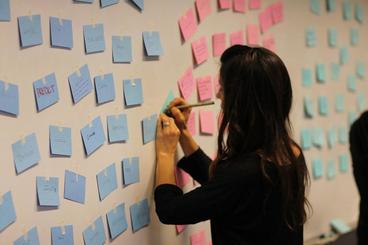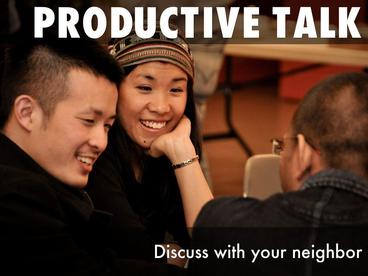
Down the Stretch: Supporting Student Writing in the Final Weeks of the Semester
Early December is crunch time on campus. The Center for Writing hums with appointments, students pack office hours, and instructors work earnestly to return midterms and papers before the Final Exam period begins. Amidst the hurly-burly, some student writers will struggle to start and manage their final writing assignments, and some instructors may feel too pressed to spend time in class addressing writing issues. This post offers three tips for how instructors can use time strategically in class to support student writing in the final weeks.
Tip 1: Encourage and model the use of invention strategies.
“According to Webster Dictionary, cloning is…” Sound familiar? While such lackluster sentences can sneak into student writing, they often function as a de facto invention technique for students—a means to discover and generate content for a larger piece of writing. Invention strategies, such as brainstorming, clustering, listing, bulletting, webbing, mind-mapping, charting, etc., can be tremendously useful when used early enough in the writing stage; however, in the absence of a prewriting stage, students may use their essays as sites of invention and exploration, which can lead to ineffective introductions and other digressive features.

Because most writers need time to write their way into a paper, it makes sense to consider using a brief amount of class time to support student invention. Faculty can support student invention in many ways. One simple and effective approach is to sequence three invention strategies— brainstorming, clustering, and freewriting. For example, if a final writing assignment requires students to work with key terms, concepts, or theories, ask students to spend 5–7 minutes brainstorming around a key term that is central to their final paper. Then ask them to cluster their ideas via lines, arrows, numbers, bubbles, or secondary lists. Modeling such an activity on the whiteboard while thinking aloud can be especially effective because it allows instructors to share how they organize thoughts, establish connections, and develop potential lines of reasoning. After they have brainstormed and clustered ideas, students are often ready to freewrite productively, to “begin putting ideas suggested by their lists or clusters into prose, even as they hold out the possibility of discovering new material” (Glenn and Goldthwaite, 169). Reserving just a few minutes of class time to model and use invention strategies can pay dividends on the final papers, and, because students will have done the inventive work prior to writing the essay, it will likely reduce the frequency of generic, dictionary-style openings at the start of student essays.
Example: A professor in Bioinformatics and Computational Biology allots time at the beginning of two consecutive class periods for students to (1) brainstorm and cluster concepts associated with a key term, and (2) draw a Venn diagram to illustrate the relationships between the concepts.
Tip 2: Use creative exercises to develop critical thinking.
Many final assignments require students to engage in core critical thinking tasks, such as developing arguments by considering opposing views; comparing and contrasting ideas and/or theories; and synthesizing material from across a range of sources. To help students get a jump on these kinds of assignments, consider spending time in class on creative activities that require making arguments, comparing and contrasting, or synthesizing ideas. In Engaging Ideas (1996), John Bean offers a number of creative, critical-thinking-oriented exercises for in-class use. Three adaptable activities include:
- Imaginary Dialogues. Ask students to write imaginary “meeting of the mind” dialogues between people with opposing views.
- Imagined Interviews with Authors. Ask students to play devil’s advocate, arguing against the author’s views and then inventing the author’s response. Some instructors extend this activity into mock panel discussions in which group members perform different roles.
- Metaphor Games & Extended Analogies. Prompt students to clarify concepts by asking them to look at X from the point of view of Y. For example, The difference between the Austrian view of economics and the Keynesian view is like the difference between ________________ and _______________ (Bean 134–138).
Because these activities are creative and engaging, they are often particularly effective at the end of the term when student anxieties and insecurities are on the rise. Regardless of when they are used, they help students identify and practice the critical thinking components necessary in more formal writing assignments.
Example: For her final essay assignment in a survey of medieval history, a professor requires students to write an essay comparing the political philosophies espoused in Thomas More’s Utopia and Niccolo Machiavelli’s The Prince. In preparation for the essay, the professor assigns an in-class activity in which students, working in pairs, write a dialogue between More and Machiavelli, who are conveniently located in the same jail cell: "The conversation soon turns toward their negative views of the sixteenth century, their vision of how a state should be ordered and ruled, their attitudes toward violence and warfare, their views about giving advice to rulers, and finally, the reasons for their incarceration. What do they say to each other?"
Tip 3: Schedule work-in-progress talks.

Work-in-progress talks are an efficient and effective way to support students on their final assignments by offering timely, responsive, and actionable feedback prior to their turning in their final projects. If conducted in class, work-in-progress talks should encourage feedback from the other students, not just the instructor, and use a simple feedback protocol such as a Wow (what ideas in the talk grab your attention?) and a Wonder (what questions do you have about the project?).
Along with offering timely feedback to writers, work-in-progress talks provide an opportunity to utilize productive talk, which research has shown to be an effective mechanism for student engagement.
Example: The final project in a Communication Studies course requires students to significantly repurpose an earlier assignment by changing its mode and target audience. In the final week of the term, the instructor schedules brief work-in-progress talks, where students explain the status of their current revision and identify one area of struggle. The other students ask questions and offer suggestions for overcoming struggles.
The end of term is often fraught with stress and anxiety, but it can also be a time of productive in-class work that supports and (re)engages students down the stretch. What in-class strategies have worked for you in the final weeks of your class? Please share your thoughts and experiences in the comment section below. If you would like to discuss possible in-class activities or support strategies, please feel free to make an appointment.
Sources
Bean, John. (1996). Engaging ideas: The professor’s guide to integrating writing, critical thinking and active learning in the classroom. San Francisco: Jossey-Bass.
Glenn, Cheryl and Goldthwaite, Melissa. (2008). The St. martin’s guide to teaching writing. Boston: Bedford.
Further support
For further support, see the Teaching with Writing resource pages, including sample assignments and syllabi. As many of you know, our WAC program also hosts the popular Teaching with Writing event series. Each semester, this series offers free workshops and discussions. Visit us online. To schedule a phone, virtual, or face-to-face teaching consultation, click here.
- Log in to post comments
Comment
Work in progress talks are…
Work in progress talks are such a useful strategy! It's a great brief follow up to peer response exercises and can even incorporate companion genres like revision memos.